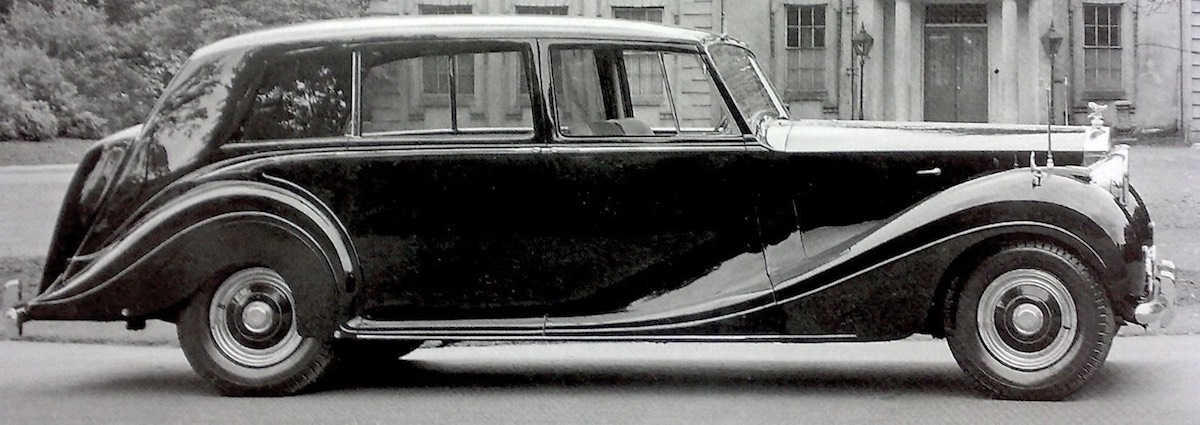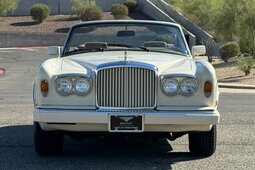Each and every vehicle crafted by Rolls-Royce, a manufacturer known for its luxurious, bespoke automobiles embodying a quintessentially British elegance, stands out as a masterpiece. However, when singling out the most extraordinary Phantom variant, the Phantom IV steals the spotlight without question.
In discussions about this automobile, it is frequently highlighted as the pinnacle of Rolls-Royce's craftsmanship and exclusivity. This is not just because of the mere 18 Phantom IV units ever produced, underscoring its rarity. The vehicle's unique place in history is further cemented by its clientele; only sovereigns and members of royal families were privileged enough to own a Phantom IV, making it an emblem of ultimate luxury and exclusivity.
Between 1950 and 1956, Rolls-Royce produced a limited series of 18 models, with 17 being acquired by some of the world's most renowned individuals, while the company retained one for its own experimental purposes. This unique model was a limousine featuring a pick-up body, showcasing Rolls-Royce's innovative approach. Despite the limited production run, variations existed among the vehicles, especially in their engines. The initial models were equipped with a 5.7-litre straight-eight engine, marking the only instance Rolls-Royce utilized an inline-eight configuration. The final three models were upgraded to feature 6.5-litre engines.
As of today, 16 of these priceless models are safeguarded in both museums and private collections worldwide. Acquiring a model in excellent condition could cost upwards of USD 1.2 million, whereas even those in lesser condition command a minimum price of USD 750,000, reflecting their unparalleled value and rarity.
First and Foremost – the Royal Family
In July 1938, Rolls-Royce found itself in the position of having to issue a statement in the automotive press, refuting rumors that the Phantom III would be phased out in favor of a new model powered by an 8-cylinder or alternative type of engine. Despite these public denials, the company was indeed in the midst of developing prototypes for a new vehicle at that time.
The year prior, in 1937, Rolls-Royce produced a seven-seater limousine affectionately referred to as "Big Bertha." Additionally, the company, which owned Bentley at the time, unveiled the Bentley Mark V in 1939. This experimental car, equipped with a straight-eight engine, was initially named the "Comet" by the Experimental Department. However, its impressive technical specifications and performance quickly earned it the more dynamic moniker of the "Scalded Cat."
In 1948, Prince Philip, Duke of Edinburgh, expressed his interest in the Scalded Cat and requested to take it for a test drive. He found the experience thoroughly enjoyable and, upon returning the vehicle, hinted at how delightful it would be to have such a car in the Royal Mews. Shortly after Prince Philip's engaging test drive, an order was placed for a Rolls-Royce motor vehicle intended for Princess Elizabeth and Prince Philip. The specifications were clear: the vehicle must embody the elegance of a limousine while possessing the robust power needed for the Prince, who intended to drive it himself. This car was to mark the first Rolls-Royce's entry into the Royal Mews, initially planned to be the singular and distinguished Phantom IV.
Aware that the royal family had been patrons of Daimler vehicles since 1900, Rolls-Royce was determined to ensure their new model surpassed all predecessors in excellence. The development spanned two years, during which Prince Philip is reported to have made several visits to the workshop to observe its progress. Upon its reveal in July 1950, the first Phantom IV was heralded as having been "designed to the special order of Their Royal Highnesses, the Princess Elizabeth and the Duke of Edinburgh," underscoring its unique status and royal approval.
The inaugural Phantom IV featured a distinctive Valentine green finish—a deep green with a subtle blue undertone—accentuated by red belt-line striping. This remained its livery until 1952 when Princess Elizabeth became queen, prompting a change to the official royal color scheme. The Phantom IV continues to serve the Royal Mews, illustrating its enduring legacy and significance. Notably, it was the vehicle of choice for Prince Charles and Camilla, Duchess of Cornwall, during the nuptials of Prince William and Kate Middleton, showcasing its lasting prominence within the royal fleet.
Initially envisioned as a singular creation, the Phantom IV's journey took an unexpected turn in 1948—before Prince Philip had even placed his order—when Rolls-Royce received a request from Spain. Generalissimo Francisco Franco expressed a desire for three armored vehicles. Despite the Phantom IV being virtually unknown beyond the confines of the manufacturer at that time, it was determined that its chassis would be ideally suited to support the substantial weight of the armor. These vehicles have remained under the stewardship of the Spanish Army ever since, continuing to play a role in various ceremonial functions.
There's no definitive record pinpointing the moment Rolls-Royce decided the Phantom IV would be exclusively manufactured for heads of state and royalty. What is clear, however, is the company's board concluded that producing more than three Phantom IVs annually would be unfeasible, and as a result, no private individuals have ever directly purchased this model. Despite the extremely limited production run of just 18 vehicles, some enthusiasts of Rolls-Royce harbored aspirations of owning a Phantom IV, though such dreams ultimately went unfulfilled.
More Famous Names
Among the select few to possess a Phantom IV was the Shah of Iran, who acquired his in 1951. This unique light blue convertible, distinguished by its white leather interior and the singular feature of having Silver Dawn headlights, stands out in the lineage of Phantom IVs. In 1959, the convertible was returned to Rolls-Royce, reportedly due to the Shah's concerns over the vehicle's durability on Iran's rugged terrain. It is documented that the car was transported to the United States from Switzerland in 1982. Despite limited photographic evidence, the car reportedly retains its light blue hue, although its current location remains a mystery.
Aga Khan III, born Sultan Muhammed Shah, was among the distinguished individuals to own a Phantom IV limousine. Unique to his purchase agreement with Rolls-Royce was a stipulation forbidding the sale of the vehicle. Nonetheless, following his passing, his widow sold the limousine to the Mayfair-Lennox hotel, which then utilized this exclusive model for guest transportation. In 2011, this particular Phantom IV made its way to the auction block at the Pebble Beach Auctions, with an estimated selling price between USD 850,000 and 1,100,000. Regrettably, no bids met the asking price, and the car remained unsold.
Another Phantom IV with a fascinating story was owned by Princess Margaret, the Countess of Snowdon. Reflecting her desire to personally operate the vehicle, it was customized with an adjustable seat. However, the modifications didn't stop there; the car was also equipped with a panoramic glass roof, a feature specifically requested by the princess, and it included a bespoke drink holder, adding to its unique allure.
In 2003, a distinguished black Phantom IV, adorned with its iconic Pegasus hood ornament, was acquired by a collector in Pennsylvania. This vehicle later made its way back to Europe from the United States after being purchased by a German collector for an estimated USD 750,000.
One of the final Phantom IVs to be manufactured was commissioned for Mohammad Reza Pahlavi, the Shah of Iran. This particular black model, featuring a grey leather interior, is notable for a unique aspect of its design. While nearly all Phantom IV models featured the iconic Spirit of Ecstasy in a kneeling position on their bonnets, the version crafted for the Shah of Iran distinguished itself with the figure standing upright.
The cessation of Phantom IV production came down to a straightforward rationale. Primarily, the hand-built Phantom IV, with its bespoke coachwork tailored to each client, proved to be financially unviable. Furthermore, with the Silver Wraith already in production and deemed perfectly suitable for heads of state, Rolls-Royce made the decision to cease the production of the exclusive Phantom IV after completing just 18 units, thus relegating it to a chapter of automotive history.
---
Discover your dream car within our Car Categories, or explore our Classic Passion Shop to uncover thrilling items from our associates!















